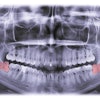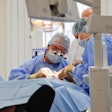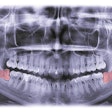Combining surgery with long-term preoperative antibiotic therapy yields the best treatment outcomes in patients suffering from bisphosphonate-related osteonecrosis of the jaw (BRONJ), according to a new study in the Journal of Oral and Maxillofacial Surgery (November 29, 2010).
Researchers from Rurh-University Bochum in Germany evaluated the role of the duration of preoperative antibiotic therapy within an otherwise standardized treatment protocol of patients with BRONJ stages I and II.
They used a retrospective chart review to analyze 46 patients with BRONJ from 2004 to 2009 who were treated with the same surgical technique and the same postoperative antibiotic treatment. Ten patients were classified as stage I and 37 as stage II. All patients had intravenous bisphosphonate therapy in their case histories.
Surgical treatment included an extended surgical procedure with sequestrectomy, bone smoothing, tension-free tissue covering, and drainage, with attention to neighboring teeth. One group of patients received a short-term preoperative antibiotic regime (A-ST), while the other a long-term preoperative antibiotic regime (B-LT). After surgery, antibiotics were given (median) for seven days intravenously and orally for another 10 to 12 days.
In group A-ST, 16 patients with 17 operations received antibiotics for one to eight days before operation, while patients in group B-LT had preoperative therapy of 23 to 54 days.
Follow-up examinations over a mean period of 17.4 months revealed that 35% of patients in group A-ST and 70% in group B-LT showed complete healing. At the time of the last clinical examination, however, 53% in group A-ST and 87% in group B-LT were free of soft-tissue dehiscence, the researchers reported.
"This study indicates that surgical treatment in patients with stage I BRONJ and especially in those with stage II BRONJ in combination with a long-term preoperative antibiotic treatment can lead to a complete healing in 70% to 87% of cases in contrast to 35% to 53% with a short-term regime," they concluded.
Copyright © 2010 DrBicuspid.com



















